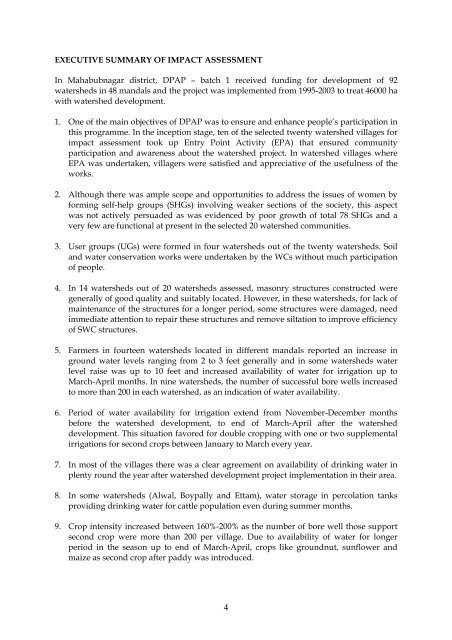Download (1660Kb) - OAR@ICRISAT
Download (1660Kb) - OAR@ICRISAT
Download (1660Kb) - OAR@ICRISAT
You also want an ePaper? Increase the reach of your titles
YUMPU automatically turns print PDFs into web optimized ePapers that Google loves.
EXECUTIVE SUMMARY OF IMPACT ASSESSMENT<br />
In Mahabubnagar district, DPAP – batch 1 received funding for development of 92<br />
watersheds in 48 mandals and the project was implemented from 1995-2003 to treat 46000 ha<br />
with watershed development.<br />
1. One of the main objectives of DPAP was to ensure and enhance people’s participation in<br />
this programme. In the inception stage, ten of the selected twenty watershed villages for<br />
impact assessment took up Entry Point Activity (EPA) that ensured community<br />
participation and awareness about the watershed project. In watershed villages where<br />
EPA was undertaken, villagers were satisfied and appreciative of the usefulness of the<br />
works.<br />
2. Although there was ample scope and opportunities to address the issues of women by<br />
forming self-help groups (SHGs) involving weaker sections of the society, this aspect<br />
was not actively persuaded as was evidenced by poor growth of total 78 SHGs and a<br />
very few are functional at present in the selected 20 watershed communities.<br />
3. User groups (UGs) were formed in four watersheds out of the twenty watersheds. Soil<br />
and water conservation works were undertaken by the WCs without much participation<br />
of people.<br />
4. In 14 watersheds out of 20 watersheds assessed, masonry structures constructed were<br />
generally of good quality and suitably located. However, in these watersheds, for lack of<br />
maintenance of the structures for a longer period, some structures were damaged, need<br />
immediate attention to repair these structures and remove siltation to improve efficiency<br />
of SWC structures.<br />
5. Farmers in fourteen watersheds located in different mandals reported an increase in<br />
ground water levels ranging from 2 to 3 feet generally and in some watersheds water<br />
level raise was up to 10 feet and increased availability of water for irrigation up to<br />
March-April months. In nine watersheds, the number of successful bore wells increased<br />
to more than 200 in each watershed, as an indication of water availability.<br />
6. Period of water availability for irrigation extend from November-December months<br />
before the watershed development, to end of March-April after the watershed<br />
development. This situation favored for double cropping with one or two supplemental<br />
irrigations for second crops between January to March every year.<br />
7. In most of the villages there was a clear agreement on availability of drinking water in<br />
plenty round the year after watershed development project implementation in their area.<br />
8. In some watersheds (Alwal, Boypally and Ettam), water storage in percolation tanks<br />
providing drinking water for cattle population even during summer months.<br />
9. Crop intensity increased between 160%-200% as the number of bore well those support<br />
second crop were more than 200 per village. Due to availability of water for longer<br />
period in the season up to end of March-April, crops like groundnut, sunflower and<br />
maize as second crop after paddy was introduced.<br />
4
















